Gopherus polyphemus Biology topics:

I. Body Structure:
Gopherus polyphemus is a member of Order Testudines (Turtles) and Family Testudinidae (Land-Dwelling Turtles/ Tortoises). Like other members of this Order and Family, gopher tortoises have a highly complex shield covering the vital organs. The shield consists of a dorsal and ventral shell composed of modified ribs, pelvis, and other bones. As labeled in the photograph at right, the dorsal shell is the carapace, and the ventral shell, the plastron. The two shells are joined by an area called the bridge.

The carapace has an oblong shape and is widest near the posterior margin of the bridge. It also has the greatest height from the plastron in the pelvic region. As shown in the photograph at left, the carapace drops downward abruptly posterior to the pelvic region.

The individual plates or scales that make up the shell are called scutes. The carapace scutes are relatively smooth due to sand abrasion created when a tortoise enters and exits the burrow. Both the carapace and plastron scutes show concentric growth rings. The ten cm wide scute in the photograph at right was found near a tortoise carcass.
The longevity of gopher tortoises is thought to be about 60 years. The counting of growth rings on scutes can be used to tell the relative ages of tortoises living in the same locale, but counting the rings is not a definitive way to determine a particular tortoise's chronological age.
As shown below, adults have a dark-brown, tan, or grayish-black carapace, while hatchlings have a yellow to yellow-orange carapace with each scute bordered in brown. Photograph of adult: Courtesy of Sheri Arnold, Conservancy of Southwest Florida volunteer. Photograph of hatchling : Courtesy of Ian Bartoszek, Conservancy of Southwest Florida biologist.


 The anterior end of the plastron has a gular projection. Gular scutes project below the chin. Males normally have longer gular projections than females, but gular projections sometimes break during aggressive and defensive encounters. The photograph at left shows the plastrons and gular scutes of a male (left) and a female (right.) Part of the female's head is visible over her gular scutes. Photograph at left: Courtesy of Ian Bartoszek, Conservancy of Southwest Florida biologist.
The anterior end of the plastron has a gular projection. Gular scutes project below the chin. Males normally have longer gular projections than females, but gular projections sometimes break during aggressive and defensive encounters. The photograph at left shows the plastrons and gular scutes of a male (left) and a female (right.) Part of the female's head is visible over her gular scutes. Photograph at left: Courtesy of Ian Bartoszek, Conservancy of Southwest Florida biologist.
Full grown gopher tortoises reach 38.7 cm in carapace length. Newly emerged hatchlings are only five cm in carapace length.
Forelimbs are long, shovel-like, and covered in large scales. Hind limbs are short and elephantine. As seen in the photograph above, the skin of the head and limbs of a hatchling is bright yellow. The color darkens as it ages.
Return to top
II. Burrow Construction:

 Gopher tortoises build their burrows in open, sunny locations where they use the burrow for nesting and thermoregulation. They choose sunny locations so they are close to their food source.
Gopher tortoises build their burrows in open, sunny locations where they use the burrow for nesting and thermoregulation. They choose sunny locations so they are close to their food source.
All gopher tortoises build burrows. Newly hatched tortoise burrows, like the one shown immediately left, are very shallow and many times just a few meters from the hatchling's birth place. Adult burrows like the one shown at far left average 4.5 m long and two m deep. The width of a burrow at a depth of 50 cm is approximately equal to the carapace length of the resident tortoise. The mouth of the burrow is eroded and enlarged. Most gopher tortoises dig several burrows during a year.
Photograph of the adult burrow above : Courtesy of Ian Bartoszek, Conservancy of Southwest Florida biologist.

An adult can dig a burrow several meters deep in about a day. The photograph at right shows an adult in the process of digging . Roll over the photograph to see the sand fly. Below, many tracks lead in and out of an active burrow.

Return to top
III. Diet:
Gopher tortoise diet includes over 300 species of plants. Their favorite foods are members of the following families: Poaceae (True Grasses), Asteraceae (Asters, Daisies, Sunflowers), Fabaceae (Legumes), Pinaceae (Pines), Chrysobalanaceae (Coco Plum, Gopher Apple), Cactaceae (Cactus), and Fagaceae (Beech and Oak Family). Members of all of these families exist within the Smith Preserve.


Tortoises enjoy eating foliage, flowers, and fruits. They are also known to eat mushrooms, scavenge carrion, and eat excrement, however in the Smith Preserve they have been observed eating only vegetation.


The Opuntia humifusa (Prickly Pear Cactus) pad at far left shows evidence of having been chewed by a gopher tortoise. The tortoise at left is feeding on Richardia grandifolia (Erect Richardia).
Return to top
IV. Excrement:

Since gopher tortoises are primarily herbivores, their dung contains fibers of plant material. As seen in this photograph, coarse-textured fibers are undigested.
Return to top

V. Reproduction:
For gopher tortoises, it is body size, not age that determines sexual maturity. Males probably mature at a smaller size than females. Size is influenced by diet and geographic location. In warmer climates which have a longer growing season, tortoises grow faster and become mature at a younger age than those living in more northern locations. In studies done in Central Florida, females were found to attain sexual maturity at nine to 16 years of age.
Photograph of tortoise : Courtesy of Ian Bartoszek, Conservancy of Southwest Florida biologist.
Mating and nesting activities take place primarily May to mid June. A male wanting to mate will position himself at the mouth of a female's burrow and display a head bobbing behavior. If the female is interested, she will exit her burrow. Then the male will walk in a circle around her, stopping along the way to perform the head bobbing display. If she approaches him, he will bob his head violently, bite her on her foreleg, head, anterior edge of the carapace, and gular projection. She will back in a semicircle; the male will follow. Eventually, the female will stop and extend her rear legs. She will rotate her body 180 degrees so her posterior end is near his head and the male will attempt to mount her.
Females often lay their single clutch of five to nine eggs in a flask-shaped nest cavity ten to 15 cm deep just outside her burrow. The brittle-shelled eggs are nearly spherical. The incubation period is about 80 days in southern Florida. Many of the eggs are killed by predators, but those eggs that survive hatch in August and September.
Return to top
VI. Predators and Parasites:
 Predators:
Predators:
Common predators of tortoise eggs include Solenopsis spp. (Fire Ants), Procyon lotor (Raccoons), Urocyon cineroargenteus (Gray Foxes), Mephitis mephitis (Striped Skunks), Didelphis virginianus (Opossums), and Dasypus novemcinctus (Armadillos).
According to David Alderton in his 1998 book, Turtles and Tortoises of the World, 90 percent of egg clutches may be destroyed before the end of the incubation period. Less than six percent of the eggs are expected to hatch with the hatchlings surviving one or more years.
The soft-shelled hatchlings and juveniles up to seven years of age are easy prey for birds and mammals as they sun themselves at the mouths of their burrows. Coyotes and domesticated and feral dogs and cats are also tortoise predators.
This photograph is of a juvenile (approximately six cm in carapace length) that was eaten. Only part of its carapace remains.
Parasites:
Tortoises of all ages are hosts of parasites that include mites, ticks, and bacteria. One type of bacteria, Mycoplasma agassizii causes URTD (Upper Respiratory Tract Disease.) This bacteria is easily spread from tortoise to tortoise. Once infected, a tortoise develops lesions in its nasal cavity, and has excessive nasal discharge and swollen and sunken eyes. In severe cases, it becomes lethargic, stops eating and dies.
Return to top
VII. Distribution And Predictions For The Species Future:

During the 1930s and 40s, gopher tortoise meat was a food source for people. At the time, hunting greatly affected tortoise populations. It was not until 1987 that Florida prohibited the hunting of gopher tortoises for food.
In recent times, another human activity is decimating tortoise populations: overdevelopment. As a result of overdevelopment, there has been a reduction of tortoise habitat; degradation of suitable habitat; and fragmentation of habitat, which isolates populations. A conservative estimate is that less than 20 percent of the xeric upland that existed in the 1960s remained in 2000.
In 2006 in Florida, Gopherus polyphemus was listed by the Florida Fish and Wildlife Commission as a threatened species. Threatened means "a species is likely to become endangered in the state within the foreseeable future if current trends continue." Some scientists feel the gopher tortoise should be listed as endangered now because it is one "whose numbers have already declined to such a critically low level or whose habitats have been so seriously reduced or degraded that without active assistance their survival in Florida is questionable.”
One approach to helping provide a healthy future for the tortoise is the purchase of land known to support their populations. The purchase of the 7.5 acre property, now the Christopher B. Smith Preserve, was made for this purpose. But with this purchase comes responsibility to keep the area in pristine condition for the tortoises.
VIII. Conservancy of Southwest Florida Tortoise Research
 At the time the 7.5 acre (19.76 hectares) preserve property was purchased in 2005, a survey of the tortoise population was conducted and a fence surrounding the property was constructed to prevent the tortoises from escaping to the busy roadways in the adjacent urban community. Sixty to 70 tortoises were living on all parts of the property except the pond, which is uninhabitable.
At the time the 7.5 acre (19.76 hectares) preserve property was purchased in 2005, a survey of the tortoise population was conducted and a fence surrounding the property was constructed to prevent the tortoises from escaping to the busy roadways in the adjacent urban community. Sixty to 70 tortoises were living on all parts of the property except the pond, which is uninhabitable.
In 2008, a comprehensive research project was conducted on the Smith Preserve tortoise population. Internet links to the 2008 research plan and list of procedures for the study are in italics in this sentence. The survey of the tortoises in this study indicate there were approximately 100 active or inactive gopher tortoise burrows, and estimates of population size ranged from 40-60 individuals based on burrow counts.
The results of the tortoise population in the 2008 study was well above what has been determined by some researchers to be the optimal number for the size of the property. One research study (Eubanks, J.O., Hollister, J.W., Guyer, C., and Michener, W. K. 2002. "Reserve area requirements of gopher tortoises (Gopherus polyphemus)." Chelonian Conservation and Biology 4 (2): 464-471) maintained that for 50 adult tortoises, you need 25 hectares to 81 hectares (62-195 acres). This was based on research tracking individuals and on calculations of burrow density. Other studies say 100 hectares (247.1 acres) is better because with less density there is less competition for food and space.
In 2012, the Conservancy's research study was repeated. See Research Plan 2012. Mark-recapture efforts from this study resulted in the collection of 73 individuals from the property.
In 2015, the survey revealed 93 active and 20 inactive burrows.
In 2018, the research study was repeated. Staff documented 44 gopher tortoises, of which 32 were recaptures-including 22 tortoises from the 2008 survey, 9 from the 2013 survey, 1 individual from the 2015 survey, and the remaining 12 were unmarked. A total of 109 burrows were located in the preserve during the April 2018 burrow survey-90 active and 19 inactive. The search for the tortoises wasn't done as aggressively as in the past, and this may account for some of the decrease in number.
 In spite of the high density of tortoises at the Smith Preserve, the tortoises appeared to be healthy and unstressed. However, because of the dense population, it is imperative that there be continuous maintenance of the habitat.
In spite of the high density of tortoises at the Smith Preserve, the tortoises appeared to be healthy and unstressed. However, because of the dense population, it is imperative that there be continuous maintenance of the habitat.
Studies show that in the absence of fire for only a few decades, a good quality gopher tortoise habitat can become too overgrown to support the grasses and herbaceous vegetation needed as food. Without the possibility of fire in the Smith Preserve because of its proximity to the urban community, removal of plant overgrowth has to be done manually. Also, new plants have to be added as tortoises graze the existing vegetation. Smith Preserve volunteers work through winter months to remove debris and invasive vegetation. They plant prickly pear cactus and other forage foods for the tortoises.
New burrows are consistently dug in the Preserve and may be affected by external events. These changes suggest that burrow surveys are just a snapshot in time and do not completely represent the continual landscape modifications made by gopher tortoises and natural events. The decline in overall tortoise captures may indicate intraspecies competition - something expected to occur due to the isolated nature of this relatively small parcel of land.
On October 28, 2022, storm surge created by Hurricane Ian flooded Smith Preserve with several feet of brackish water from the Gordon River. Several tortoises were impacted with sand and taken to the Conservancy Wildlife hospital for rehabilitation. They were later returned to the Preserve. As of December 2022, volunteers and staff of the Science Division do not note any decrease in the number of tortoises. Tortoises appear to be healthy and not suffering from stress. Their normal forage foods are numerous and available. Muscadine grape vines are especially abundant. Volunteers from the Wildlife Hospital, thinking that the tortoises were starving, planted Bahia grass to supplement their diet. Debris from the Hurricane is being removed to make easy accessibility for the tortoises to reach their normal forage foods.
On September 19, 2024, the Conservancy hosted Florida Fish and Wildlife Conservation Commission (FWC) veterinarian Dr. Rebecca Hardman and her team to conduct a "bioblitz" sampling event. This was one of several to be conducted in Florida. Dr. Hardman's FWC team included Kyle Brown, Gopher Tortoise Program Coordinator, and David Steen, Herpetology Research Leader. FWC is interested in obtaining baseline data on pathogens present in certain gopher tortoise populations at high risk of harboring pentasomes (an internal parasite) and/or TFV (Turtle fraservirus). Smith Preserve, Naples Preserve, Marco Island, and several sites in Okeechobee are being targeted for the study. Prior to September 19th, sampling had already occurred in the Tall Timbers area of Florida.
The Conservancy's Wildlife Hospital, worked collaboratively with FWC on this project, with the potential result being aid not only for our local tortoises, but for the threatened gopher tortoise population as a whole. In total FWC sampled 11 tortoises from the Smith Preserve, 15 from Naples Preserve, and 34 from Marco Island and Isle of Capri.
Sampling performed on each tortoise included physical exam, oral, cloacal and shell swab sampling, venipuncture, fecal analysis, and radiology. The exact location where each tortoise was captured was recorded and each tortoise was returned exactly where it was found. Strict protocols were in place to avoid cross contamination between tortoise populations during the entire process.
The collaboration required during the sampling event was extensive. Staff and volunteers from multiple organizations worked together with a common goal that will ultimately benefit gopher tortoises.
Below: Left: FWC staff member looking for tortoises in the preserve. Right: Physical exam in the Wildlife Hospital. ( Photographs: Courtesy of Conservancy Wildlife Hospital.)

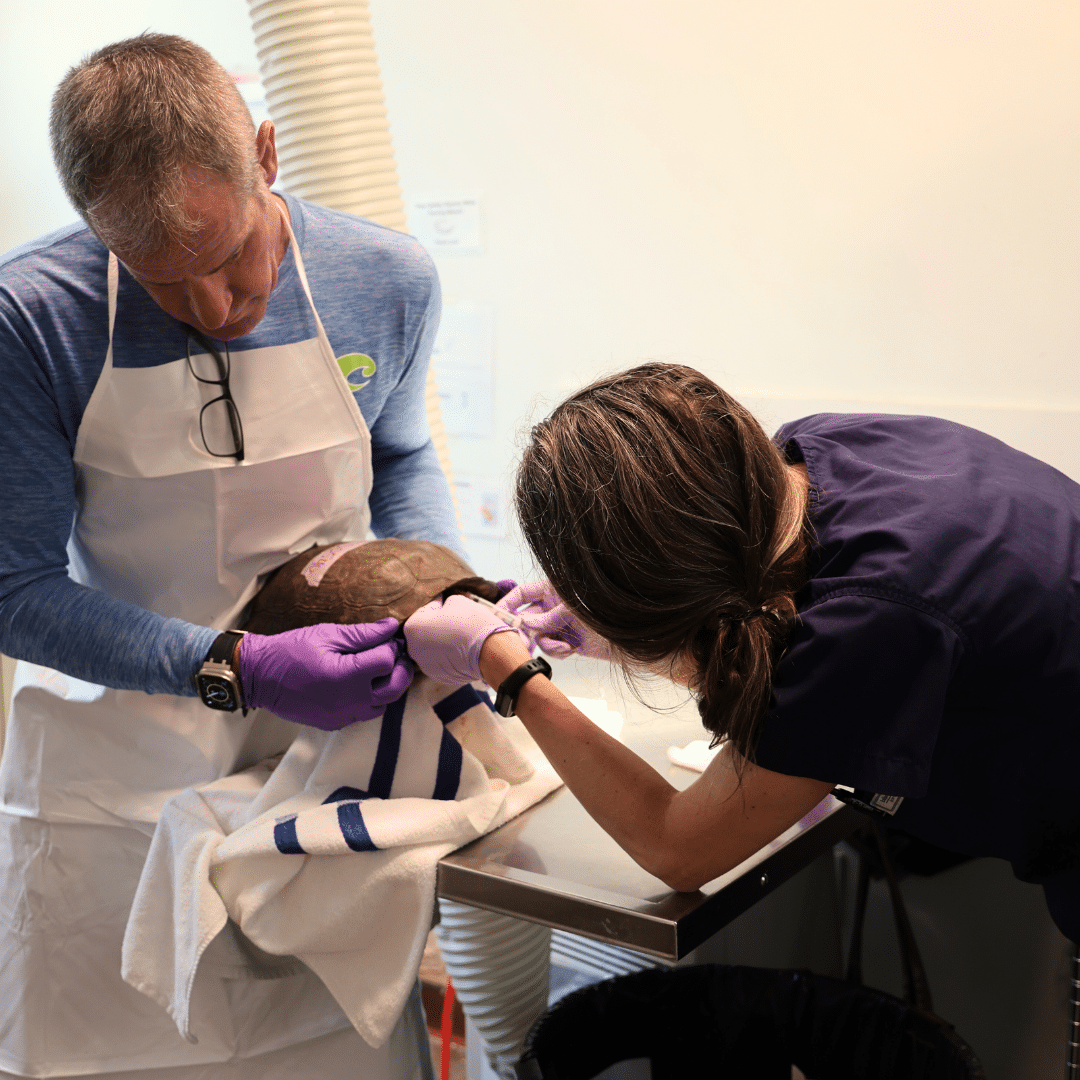
Below: Conservancy volunteers helped in locating tortoises. The beautiful liatris were in full bloom. (Photographs: Courtesy of Bridget Washburn, Conservancy Volunteer Coordinator)
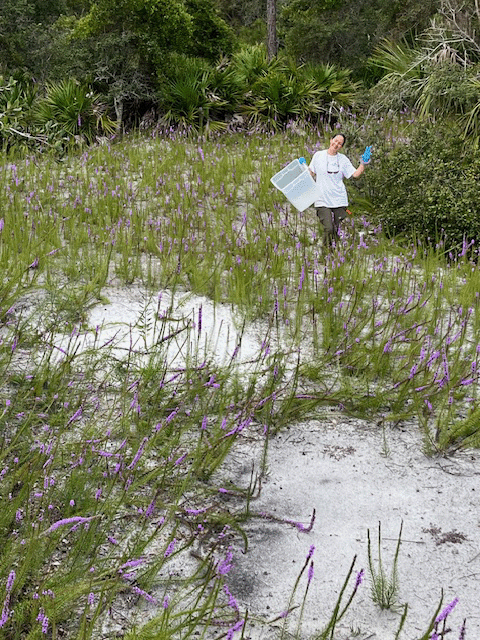
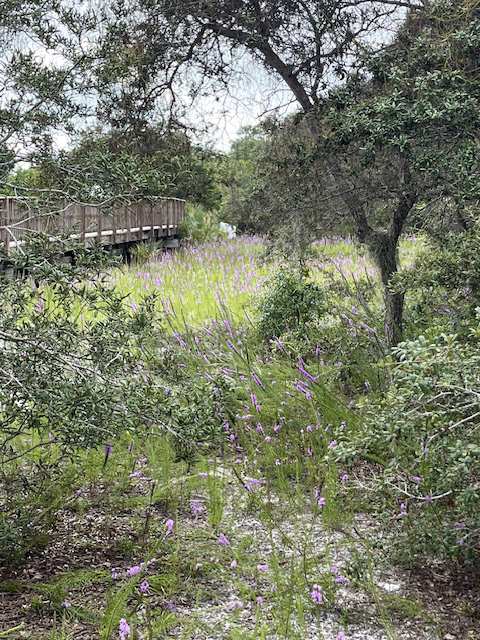
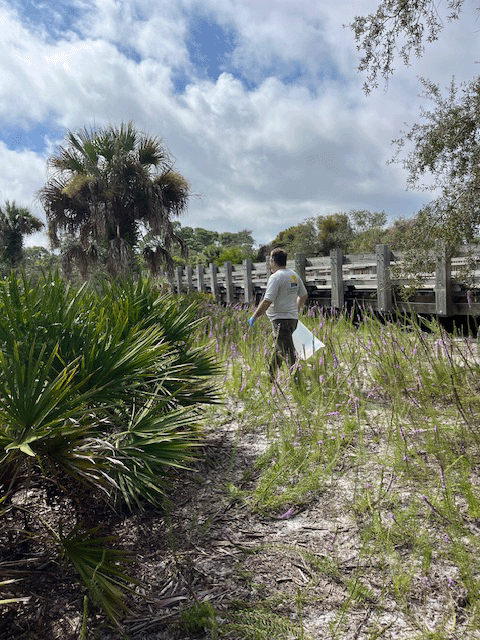
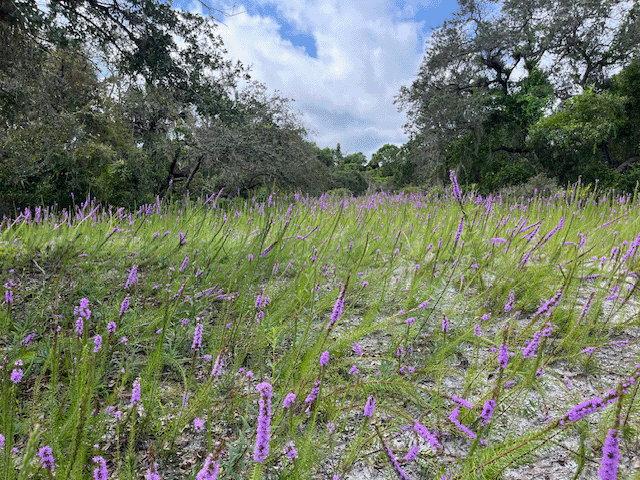

Below: Another physical exam of a tortoise in the Wildlife Hospital. (Photograph: Courtesy of Bridget Washburn, Conservancy Volunteer Coordinator).

Return to top
 In studies of gopher tortoise burrows, 60 vertebrates and over 300 invertebrates are known to use gopher tortoise burrows. Some include: newts, frogs, toads, American alligators, box turtles, green anoles, other lizards, skinks, snakes, bobwhites, owls, wrens, robins, sparrows, opossums, armadillos, domestic dogs, coyotes, foxes, raccoons, skunks, weasels, bobcats, squirrels, mice, rats, cottontails, land snails, crayfish, whip scorpions, pseudoscorpions, spiders, mites, ticks, centipedes, millipedes, crickets, grasshoppers, walkingsticks, cockroaches, true bugs, antlions, beetles, caterpillars, moths, crane flies, gnats, scavenger flies, robber flies, long-legged flies, dung flies, fleas, wasps, and ants. Some of these species, like Drymarchon couperi (Eastern Indigo Snake) are rare and threatened Florida species.
In studies of gopher tortoise burrows, 60 vertebrates and over 300 invertebrates are known to use gopher tortoise burrows. Some include: newts, frogs, toads, American alligators, box turtles, green anoles, other lizards, skinks, snakes, bobwhites, owls, wrens, robins, sparrows, opossums, armadillos, domestic dogs, coyotes, foxes, raccoons, skunks, weasels, bobcats, squirrels, mice, rats, cottontails, land snails, crayfish, whip scorpions, pseudoscorpions, spiders, mites, ticks, centipedes, millipedes, crickets, grasshoppers, walkingsticks, cockroaches, true bugs, antlions, beetles, caterpillars, moths, crane flies, gnats, scavenger flies, robber flies, long-legged flies, dung flies, fleas, wasps, and ants. Some of these species, like Drymarchon couperi (Eastern Indigo Snake) are rare and threatened Florida species. 
















 Predators:
Predators: 
 At the time the 7.5 acre (19.76 hectares) preserve property was purchased in 2005, a survey of the tortoise population was conducted and a fence surrounding the property was constructed to prevent the tortoises from escaping to the busy roadways in the adjacent urban community. Sixty to 70 tortoises were living on all parts of the property except the pond, which is uninhabitable.
At the time the 7.5 acre (19.76 hectares) preserve property was purchased in 2005, a survey of the tortoise population was conducted and a fence surrounding the property was constructed to prevent the tortoises from escaping to the busy roadways in the adjacent urban community. Sixty to 70 tortoises were living on all parts of the property except the pond, which is uninhabitable.  In spite of the high density of tortoises at the Smith Preserve, the tortoises appeared to be healthy and unstressed. However, because of the dense population, it is imperative that there be continuous maintenance of the habitat.
In spite of the high density of tortoises at the Smith Preserve, the tortoises appeared to be healthy and unstressed. However, because of the dense population, it is imperative that there be continuous maintenance of the habitat. 






